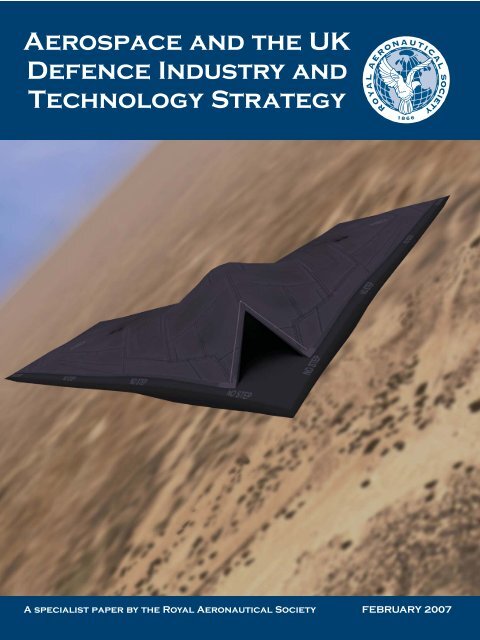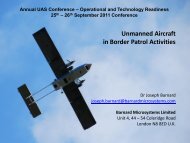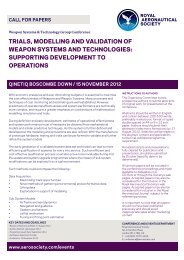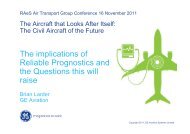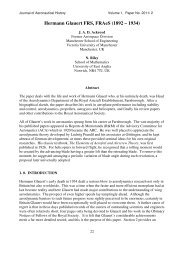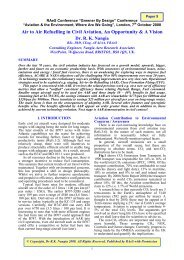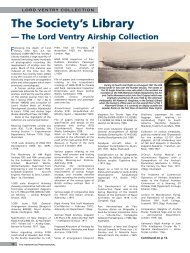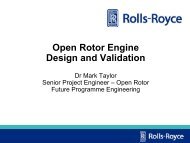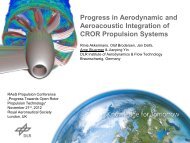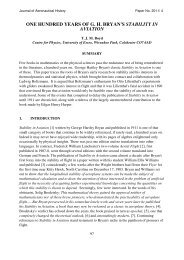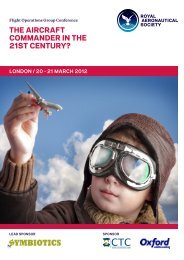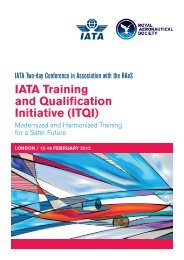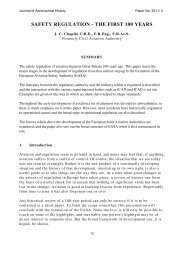DTS Paper.qxp - Royal Aeronautical Society
DTS Paper.qxp - Royal Aeronautical Society
DTS Paper.qxp - Royal Aeronautical Society
Create successful ePaper yourself
Turn your PDF publications into a flip-book with our unique Google optimized e-Paper software.
Aerospace and the UK<br />
Defence Industry and<br />
Technology Strategy<br />
A specialist paper by the <strong>Royal</strong> <strong>Aeronautical</strong> <strong>Society</strong><br />
FEBRUARY 2007
ROYAL AERONAUTICAL SOCIETY<br />
2<br />
<strong>Royal</strong> <strong>Aeronautical</strong> <strong>Society</strong><br />
At the forefront of change<br />
Founded in 1866 to further the science of aeronautics, the <strong>Royal</strong> <strong>Aeronautical</strong> <strong>Society</strong> has been at the forefront of developments<br />
in aerospace ever since. Today the <strong>Society</strong> performs three primary roles:<br />
■ to support and maintain the highest standards for professionalism in all aerospace disciplines;<br />
■ to provide a unique source of specialist information and a central forum for the exchange of ideas;<br />
■ to exert influence in the interests of aerospace in both the public and industrial arenas.<br />
Benefits<br />
■ Membership grades for professionals and enthusiasts alike<br />
■ Over 19,000 members in more than 100 countries<br />
■ Over 70 Branches across the world<br />
■ Dedicated Careers Centre<br />
■ Publisher of three monthly magazines<br />
■ Comprehensive lecture and conference programme<br />
■ One of the most extensive aerospace libraries in the world<br />
The <strong>Society</strong> is the home for all aerospace professionals, whether they are engineers, doctors, air crew, air traffic controllers, lawyers,<br />
to name but a few. There is a grade of membership for everyone — from enthusiasts to captains of industry.<br />
To join the <strong>Society</strong> please contact the Chief Executive, <strong>Royal</strong> <strong>Aeronautical</strong> <strong>Society</strong>, 4 Hamilton Place, London W1J 7BQ, UK.<br />
Tel: +44 (0)20 7670 4300. Fax: +44 (0)20 7670 4309. e-mail: raes@raes.org.uk<br />
The <strong>Royal</strong> <strong>Aeronautical</strong> <strong>Society</strong> has 20 Specialist Interest Group Committees, each of which has been set up to represent the<br />
<strong>Society</strong> in all aspects of the aerospace world. These committees vary in size and activity but all their members contribute an<br />
active knowledge and enthusiasm. The Groups meet four or five times a year and their main activities centre around the production<br />
of conferences and lectures, with which the <strong>Society</strong> fulfils a large part of its objectives in education and the dissemination of<br />
technical information.<br />
This work is valuable not only in terms of the <strong>Society</strong>’s charter objectives but also financially, as the conference programme<br />
contributes to the <strong>Society</strong>’s annual income.<br />
In addition to planning these conferences and lectures, the Groups also act as focal points for the information enquiries and<br />
requests received by the <strong>Society</strong>. The Groups therefore form a vital interface between the <strong>Society</strong> and the world at large, reflecting<br />
every aspect of the <strong>Society</strong>’s diverse and unique membership.<br />
By using the mechanism of the Groups, the <strong>Society</strong> covers the interests of operators and manufacturers, military and civil aviators,<br />
commercial and research organisations, regulatory and administrative bodies, engineers and doctors, designers and distributors,<br />
company directors and students, and every other group of professionals who work within aerospace. No other institution<br />
represents such a wide and varied range of professions.<br />
The <strong>Society</strong> membership must ensure that these Groups continue to reflect the constant innovation and development of aviation.<br />
This can be achieved only by regular input from members. The Group Committees would welcome new members and those<br />
interested should write to the chairman of the relevant committee c/o the Conference and Events Department.<br />
The Specialist Groups are: Aerodynamics, Air Finance, Air Law, Air Power, Air Transport, Airworthiness & Maintenance, Aviation<br />
Medicine, Avionics & Systems, Environment (called Air Travel Greener by Design), Flight Operations, Flight Simulation, Flight Test,<br />
General Aviation, Historical, Human Factors, Human Powered Aircraft, Management Studies, Propulsion, Rotorcraft, Space,<br />
Structures & Materials and Weapon Systems & Technology. If you feel you can provide an input, or expand the interests covered by<br />
a particular group, please act today and get in touch. Remember, the RAeS is only as influential as the members make it.<br />
This paper was prepared by Professor Keith Hayward, Head of Research at the <strong>Royal</strong> <strong>Aeronautical</strong> <strong>Society</strong>. He would<br />
like to thank members of the <strong>Society</strong>’s Specialist Committees who commented upon early drafts of this paper.<br />
However, the analysis and views expressed in the paper are his and do not represent those of the <strong>Society</strong> as a whole.<br />
<strong>Royal</strong> <strong>Aeronautical</strong> <strong>Society</strong><br />
4 Hamilton Place, London W1J 7BQ, UK<br />
Tel +44 (0)20 7670 4300 Fax +44 (0)20 7670 4309 e-mail raes@raes.org.uk Web http://www.aerosociety.com £25<br />
Aerospace and the UK Defence Industry and Technology Strategy
Aerospace and the UK<br />
Defence Industry and<br />
Technology Strategy<br />
EXECUTIVE SUMMARY<br />
A Specialist <strong>Paper</strong> prepared by<br />
Prof Keith Hayward, FRAeS †<br />
Head of Research at the <strong>Royal</strong> <strong>Aeronautical</strong> <strong>Society</strong><br />
In publishing its Defence Technology Strategy, the UK Ministry of Defence has now completed the first stage of its ‘roadmap’ for the<br />
future of the UK defence industrial base and its main technological concerns. The MoD framework provides a set of guiding principles<br />
and an indication of priorities for both the MoD and industry. As such, they have been welcomed by industry as a means of guiding<br />
its investment with a higher degree of confidence than hitherto and enabling companies to play their full part in meeting MoD<br />
requirements over the next decade.<br />
This Discussion <strong>Paper</strong> examines the implications for the UK aerospace sector of the MoD’s strategy. It outlines the main features of the<br />
two key MoD documents 1 but its main focus is on the implications of the Defence Technology Strategy on the aerospace sector. These<br />
will be profound: the MoD is unlikely to invest in conventional aircraft platform technology beyond the Typhoon and F-35. There will<br />
be investment in mission systems and complex weapons technology acquisition as well as in systems integration. Materials technology<br />
is also seen as a key cross-cutting investment. Research will also be focused on improving through life support and maintenance. The<br />
strategy confirms the movement towards unmanned systems and networks.<br />
Industry will be expected increasingly to support its own applied research in part shaped by reference to the MoD’s now published<br />
guidelines. However, there are unresolved issues relating to the long-term stability of the MoD plan and UK companies may continue<br />
to find greater opportunities offshore with the risk of increased dependence on particularly the US market with its restrictions on<br />
technology transfer.<br />
The <strong>DTS</strong> poses a major challenge to the conventional view of an aerospace professional. Working on defence projects will remain a<br />
stimulating and rewarding intellectual career — indeed, the more so given the complexity of some of the high level systems envisaged<br />
for the future. The demand will be for flexible, adaptable professionals, perhaps with a wider range of educational experience than<br />
the traditional aerospace engineer. However, maintaining the human base of the UK defence industry will not come cheap to maintain<br />
real capability, but it should be an essential element in a long-term strategy<br />
While the MoD’s view of the future is based on a solid diagnosis of the trends and developments in the defence industrial sector, the<br />
prescription offered in terms of technology investment is more geared to the MoD’s needs and concerns. While this may be<br />
understandable, there is a risk overall of some diversion between the MoD’s requirements and those of UK-based industry.<br />
While the <strong>Royal</strong> <strong>Aeronautical</strong> <strong>Society</strong> is not directly involved in the evolution of UK defence industrial and technological policy, it does<br />
have a role in monitoring events on behalf of its members, contributing to the debate on policy and, through its specialist committees,<br />
helping to shape views about emerging technologies.<br />
1 Ministry of Defence, Defence Industrial Strategy, December 2005 and<br />
Ministry of Defence, Defence Technology Strategy, October 2006.<br />
† Prof Hayward is Head of Research at the <strong>Royal</strong> <strong>Aeronautical</strong> <strong>Society</strong>. He is the author of several books and articles<br />
on defence and aerospace and has been a consultant to public and private agencies in the UK, US and Europe.<br />
FEBRUARY 2007 3
4<br />
Aerospace and the UK<br />
Defence Industry and<br />
Technology Strategy<br />
CONTENTS<br />
Background ............................................................................ 5<br />
The UK Defence Technology and Industry Strategies —<br />
Main Themes ....................................................................5<br />
The <strong>DTS</strong> — A 25-year Outlook ..............................................6<br />
Crosscutting Capabilities Technologies ................................ 7<br />
Aerospace in the DIS and <strong>DTS</strong> .............................................. 7<br />
International Collaboration, Market Access and<br />
Technology Transfer ........................................................ 9<br />
The Future of the Aerospace Professional .........................10<br />
Final Observations ................................................................11<br />
A Role for the <strong>Royal</strong> <strong>Aeronautical</strong> <strong>Society</strong> ........................ 12<br />
Aerospace and the UK Defence Industry and Technology Strategy
The two current major military aerospace programmes are Typhoon (left), now entering service, and F-35 Lightning II (right) which made its first<br />
flight in December 2006.<br />
1.0 BACKGROUND<br />
1. The MoD has now completed the first iteration of its long-term<br />
strategy for the UK defence technology and industry base (DTIB).<br />
Its approach to the industrial component was outlined in the<br />
Defence Industry Strategy (DIS) paper of December 2005 2. The DIS<br />
has been now complemented by the Defence Technology<br />
Strategy (<strong>DTS</strong>) published in October 2006. Together these<br />
documents and other ministerial statements set out a 20-25-year<br />
perspective for UK defence procurement and research<br />
investment. This is the most comprehensive policy for the DTIB<br />
ever published by the MoD. While not necessarily offering a<br />
detailed prescription for future procurement decisions, the DIS<br />
and <strong>DTS</strong> present a framework, a set of guiding principles and an<br />
indication of priorities for both the MoD and industry. As such,<br />
they have been welcomed by industry as a means of guiding its<br />
investment with a higher degree of confidence than hitherto and<br />
enabling companies to play their full part in meeting MoD<br />
requirements over the next decade.<br />
2. This paper discusses the implications for the UK aerospace<br />
industry of the MoD’s DTIB policy as expressed in the DIS and the<br />
<strong>DTS</strong> 3. It briefly recapitulates the main themes of the two<br />
documents with specific reference to the aerospace sector.<br />
However, the main focus is on the 20-25-year technology strategy<br />
and the likely direction this implies for the UK aerospace industry.<br />
A 50-year perspective is not unrealistic given that the F-35/JSF will<br />
be in front line service for much of this period and Unmanned<br />
Airborne Systems (UAS) concepts will shape air power delivery<br />
whatever the specific platform characteristics they may possess.<br />
3. As the UK sets out to celebrate the first 100 years of manned<br />
aviation and of the first steps in the evolution of a domestic<br />
aircraft/aerospace industry, the following conclusions offered may<br />
be unsettling: the future of combat aviation will certainly confirm<br />
the shift away from aerospace as such to airborne systems, with<br />
conventional manned fixed and rotary wing aeroplanes largely<br />
2 Ministry of Defence, Defence Industrial Strategy, December 2005 and<br />
Ministry of Defence, Defence Technology Strategy, October 2006.<br />
3 A <strong>Society</strong> view on the DIS was expressed in a memorandum submitted<br />
to the House of Commons Defence Committee, Seventh Report of<br />
Session 2005-06 Defence Industry Strategy, HC 824, May 2006.<br />
providing tactical and logistic support. This will imply on the one<br />
hand a different industrial supply chain and on the other<br />
domestic vulnerability to increased global competition. The DTIB<br />
strategy will undoubtedly help UK industry to make the necessary<br />
adjustments and transition to a new business model, but the<br />
process will not be easy nor without casualties.<br />
2.0 THE UK DEFENCE TECHNOLOGY AND<br />
INDUSTRY STRATEGIES — MAIN THEMES<br />
The changing context of defence technology acquisition<br />
4. The defence environment is changing and at faster rate than at<br />
perhaps any time since the end of WW2. As the <strong>DTS</strong> puts it:<br />
“Never has there been greater uncertainty in the nature of the<br />
threat faced by the UK, nor has that threat adapted and changed<br />
so rapidly. This demands rapid evolution in our response, both<br />
tactically and in the technologies we deploy to combat the<br />
threats.” 4 The DIS “provided greater transparency of the MoD’s<br />
future defence requirements and, for the first time, set out those<br />
industrial capabilities needed to ensure we can operate our<br />
equipment in the way we choose.” The <strong>DTS</strong> is designed to provide<br />
a “highly innovative, agile and flexible” approach to defence<br />
research. The key word being ‘strategic’, with an emphasis on<br />
meeting the MoD’s ‘core needs’, which includes a ‘clear emphasis’<br />
on Through Life Capability Management (TLCM) and a<br />
‘comprehensive engagement’ between MoD and its collaborative<br />
partners and its technology supply base.<br />
Appropriate Sovereignty<br />
5. Underpinning both the DIS and the <strong>DTS</strong> is the concept of<br />
Appropriate Sovereignty. The MoD recognises that a significant<br />
proportion of its equipment needs will be satisfied by overseas<br />
suppliers or foreign-owned companies located in the UK. Foreign<br />
ownership per se is not a problem for the MoD as long as the<br />
work and technology remains on on-shore. The DIS tries to tell<br />
industry “very clearly where, to maintain our national security<br />
and keep the sovereign ability to use our Armed Forces in the way<br />
we choose, we need particular industrial capabilities in the UK.”<br />
Appropriate Sovereignty has three dimensions: strategic<br />
4 <strong>DTS</strong>, A1.1<br />
FEBRUARY 2007 5
assurance (capabilities which are to be retained onshore as they<br />
provide technologies or equipment important to safeguard the<br />
state, e.g. nuclear deterrent); defence capability (where the MoD<br />
requires particular assurance of continued and consistent<br />
equipment performance); and strategic influence (in military,<br />
diplomatic or industrial terms), as well as recognising potential<br />
technology benefits attached to these which have wider value. 5<br />
6. But as the DIS makes clear, even where the MoD would like an<br />
industrial capability to be sustained in the UK for strategic<br />
reasons, that does not necessarily preclude global competition in<br />
that sector for some projects. The MoD cannot afford to maintain<br />
a complete cradle-to-grave industrial base in all areas. Industry<br />
also will make independent investment decisions and an<br />
important indigenous capability as a result may disappear.<br />
Equally, the MoD does not aim to restrict the scope for<br />
international co-operation and competition where this is<br />
appropriate. The DIS does not seek to set out a preferred route to<br />
international restructuring. This is to be left to industry. Nor does<br />
it set out a preferred route to international restructuring as this<br />
will also be left to Industry. What is missing is a clear view or even<br />
some indication from the MoD of its vision for the future in terms<br />
of general structure of the UK Defence Industrial Base. The MoD<br />
has provided elements of a strategy but it has not looked forward<br />
through the next 10-15 years to assess the consequences. This<br />
would have provided an additional and vital perspective for<br />
Industry’s future. Defence is a long-term business and can change<br />
rapidly as circumstances change but a view, however tentative<br />
from Industry’s major customer, would have helped companies to<br />
understand the long-term strategic direction of the MoD.<br />
Total Life Cycle Management, partnership and a new<br />
business model<br />
7. A key feature of the new policy is the adoption of a partnership<br />
approach to both equipment development and production that<br />
fully embraces TLCM concepts. The <strong>DTS</strong> will also increasingly<br />
require industry to accept a greater share of the risk of applied<br />
research and technology demonstration. The MoD has recognised<br />
the limitations of a pure competition centric model of defence<br />
procurement. The role of competition to encourage efficiency<br />
and value for money remains important but only when<br />
appropriate. Instead, the MoD is to develop long-term<br />
partnerships with major companies, primarily though not<br />
exclusively with traditional prime contractors. This reflects in part<br />
the rapid changes in the defence industrial environment since the<br />
end of the Cold War, especially the increasing globalisation of<br />
defence companies and the importance of civil technology to<br />
modern defence systems, particularly in the areas of electronics<br />
and information technology. Changing times will force the<br />
adoption of new business models on the part of both supplier and<br />
customer.<br />
8. Moving the focus of procurement from delivering a simple ‘end<br />
product’ to a fully supported product life cycle implies a radical<br />
change in the UK defence business model and a different<br />
approach to extracting the best return economically and<br />
industrially from national investment in defence procurement. UK<br />
industry should have no illusions that this will have a profound<br />
impact on much of the supply chain whose role in supporting and<br />
upgrading equipment may be limited, or where the size of<br />
individual companies precludes the necessary investment to adapt<br />
to the new business model.<br />
9. The UK defence industry from top to bottom cannot expect to<br />
remain unaffected by these developments. Over the past two<br />
decades, the UK has fully embraced interdependence in many<br />
5 DIS Section A5.<br />
6<br />
Aerospace and the UK Defence Industry and Technology Strategy<br />
critical areas of defence procurement with the aerospace sector<br />
leading the way through successive generations of international<br />
collaboration. The UK defence aerospace sector is irrevocably<br />
linked to a global network of design, development and<br />
production. This has entailed a loss of autonomous capability to<br />
produce complete aerospace systems, but collaboration and other<br />
international links have allowed the maintenance of an overall<br />
capability that otherwise would have been unsustainable based<br />
on the UK market alone.<br />
3.0 THE <strong>DTS</strong> — A 25-YEAR OUTLOOK<br />
10. It has become part of the conventional wisdom that, without<br />
an adequate technology base, UK-located defence capabilities<br />
will decline and its industry fall behind in a globalising defence<br />
market. It is equally obvious that, in a period of transition from<br />
platform to network enabled technologies the UK should invest<br />
even more in the defence technology base and to integrate the<br />
opportunities afforded by commercial technology streams. The<br />
<strong>DTS</strong> follows several recent initiatives to improve the planning and<br />
delivery of defence technology acquisition. For example there has<br />
been an improvement in the co-ordination of aerospace R&D as<br />
exemplified by the development of a National Aerospace<br />
Technology Strategy as one of the recommendations of the DTI<br />
Aerospace Innovation and Growth Team (AeIGT) report.<br />
11. Such developments, if followed through, will bring real benefits<br />
to the UK defence industrial base. Indeed, the MoD intends to<br />
utilise and, if appropriate, participate in AeIGT programmes.<br />
However, these sentiments will come to naught without adequate<br />
funding. The MoD has recently begun to address some years of<br />
relative neglect in this respect. Failure to maintain commitments in<br />
this area would nullify all of the good work entailed in setting out<br />
a comprehensive defence industrial strategy.<br />
12. Equally, early investment in technology increases the<br />
confidence in predicting the cost and performance of new<br />
programmes to the overall benefit of the procurement process.<br />
Reducing the length of time expended in developing new<br />
equipment also depends upon a steady introduction of new<br />
technology through a process of incremental development<br />
drawing from a continual stream of defence specific as well as<br />
civil technological innovation. This is explored at some length in<br />
the DIS and echoes similar findings based on US experience and<br />
analysis. Again, the test of good intentions will be in changing<br />
practices and fully applying the lessons of past procurement. Most<br />
important, the customer will have to resist the dual temptations<br />
of demanding too much at the outset of a new programme and<br />
of interfering in the process of development to capture the latest<br />
example of new technology.<br />
13. The <strong>DTS</strong> recognises the clear correlation between the absolute<br />
level of national investment in research and development and the<br />
quality of military equipment. The UK has an advanced defence<br />
technology base, second only to the US, albeit at some distance.<br />
This is the result of investments made over the past 20-25 years<br />
and has allowed the UK to play a leading role in European<br />
collaboration and has facilitated a very effective relationship with<br />
the US. As a guide to policy, the MoD has set the target of<br />
matching the world’s major defence exporting nations. 6<br />
14. The MoD will continue to invest in the most challenging, longterm<br />
aspects of defence science and technology but will<br />
increasingly expect industry to fund a substantial share of applied<br />
and demonstrator technology. Increased collaboration with allies<br />
(primarily the US and selected European countries) and the<br />
6 <strong>DTS</strong> Section A2.
oader national science base will also figure in future planning.<br />
However, the <strong>DTS</strong>’s primary goal is to identify those areas of<br />
defence science and technology essential to maintain national<br />
sovereign capability, provide maximum leverage in strategic<br />
terms and provide the most overall technology benefit to the UK.<br />
In many sectors, the main focus is on through life management<br />
where the MoD will primarily invest in technologies designed to<br />
facilitate upgrading and long-term affordability. This includes<br />
commitment to developing open systems and systems<br />
architectures that will enable greater long-term flexibility and<br />
adaptability. In many cases the MoD intends to retain control over<br />
critical systems architectures.<br />
4.0 CROSS-CUTTING CAPABILITIES TECHNOLOGIES<br />
15. The MoD will seek to maximise returns from its investment,<br />
looking to derive multiple use from research. In this respect, the<br />
<strong>DTS</strong> puts considerable emphasis on cross-cutting technologies<br />
that will have the greatest impact across the range of defence<br />
equipment sectors. These are:<br />
■ Sensors and countermeasures<br />
■ Information exploitation<br />
■ Human factors<br />
■ Platforms and structures<br />
■ The physical environment<br />
■ Technologies to enable Through Life Capability Management<br />
(TLCM)<br />
Many of the individual technologies under this heading will be of<br />
relevance to aerospace — for example, simulation technologies<br />
have a priority in the human factors area. However, increased<br />
dependence on commercial sources, again noted in the<br />
simulation case, might place UK firms at a disadvantage if foreign<br />
competitors continue to receive funding through national<br />
defence and civil R&D budgets.<br />
16. C4ISTAR is also identified as a cross-cutting technology<br />
because of its role in most of the individual sectors and its<br />
centrality to delivering the MoD’s Network Enabling Capability<br />
(NEC). This is by definition a complex system of systems in which<br />
the aerospace element strictly defined is limited to the provision<br />
of aircraft and satellite platforms. There is no need automatically<br />
to buy these from a UK supplier unless there is a specific<br />
technological value in integrating platform with equipment and<br />
sub systems. The DIS, for example, recognises this in relation to<br />
micro satellites where the UK has a strong niche capability.<br />
17. Systems Engineering and Integration is rightly afforded<br />
prominence in the DIS. This capability is at the top of the defence<br />
industrial value chain. UK industry has a wide and deep set of<br />
capabilities across a wide-range of defence applications. On shore<br />
systems engineering and integration afford vital access points for<br />
high value UK-based equipment suppliers and will be essential in<br />
facilitating UK-based up grading and support. The DIS also reiterates<br />
the view that such skills are not monopolised by the<br />
traditional prime contractors but are possessed, perhaps more<br />
relevantly, by high-level equipment and IT companies. The key<br />
caveat must be whether the UK has sufficient systems engineers<br />
to meet these requirements. Nor is it clear from either the DIS or<br />
the <strong>DTS</strong> how the MoD intends to fund ‘systems integration’ R&D.<br />
By definition, such activity tends to be of a ‘one-off’ nature and<br />
thus a business case for industry investment is difficult to make.<br />
One approach used in the commercial world could be for the<br />
MoD and industry to work together to formulate the<br />
requirements for an MoD system to incorporate technologies for<br />
which an industry investment case could then be created.<br />
Procuring the Typhoon (above) and the JSF has removed the<br />
requirement “for the UK to design and build a future generation of<br />
manned fast jet aircraft for the foreseeable future.”<br />
5.0 AEROSPACE IN THE DIS AND <strong>DTS</strong><br />
18. For the aerospace sector (here defined as fixed wing, rotary<br />
wing, complex weapons, airborne mission systems, and some<br />
space elements), the DIS and <strong>DTS</strong> present some major challenges<br />
as well as some important opportunities. The continuing vital role<br />
of airpower, precision weapons and the C4ISTAR functions<br />
facilitated by air and space platforms are reiterated at length by<br />
the DIS and <strong>DTS</strong>. The UK also has substantial world-class design<br />
and development expertise in manned aircraft construction and<br />
systems integration, the development of guided weapons and in<br />
a wide range of mission systems. However, these statements are<br />
matched by a clear statement that the future will not be like the<br />
past and that the conventional view of airpower and its<br />
supporting domestic DTIB will be replaced by a different set of<br />
priorities, equipment needs and industrial infrastructure.<br />
Fixed Wing Aircraft<br />
19. The most telling aspects of the DIS and <strong>DTS</strong> are encompassed<br />
by two related assertions based on a view of contemporary trends<br />
in procurement, ever-increasing development costs, longer<br />
equipment life times and consequently fewer numbers that are<br />
eventually procured. This has been especially evident in fixed<br />
wing combat aircraft. Bluntly, procuring the Typhoon and the JSF<br />
has removed the requirement “for the UK to design and build a<br />
future generation of manned fast jet aircraft for the foreseeable<br />
future.” The main DTIB requirement henceforward will be to<br />
retain the technological base to upgrade and integrate new<br />
technologies. The provision of transport and other large aircraft<br />
platforms will be treated as a commodity to be acquired from<br />
international suppliers. Only specific UK operationally relevant<br />
technologies and through life management issues will require<br />
national technology investment.<br />
20. Moreover, in too many cases the flexibility and agility of<br />
airpower has not been “matched by agility in major aerospace<br />
programmes. The time and cost of relatively modest platform<br />
upgrades has too often been hard to justify and air power risks<br />
pricing itself out of business.” On the other hand, the<br />
development of Unmanned Airborne Systems is seen as a major<br />
opportunity to address the traditional economics of<br />
development, manufacture and employment of air systems. The<br />
<strong>DTS</strong> assigns a high priority to airborne sensors, defensive<br />
FEBRUARY 2007 7
electronics and complex weapons. UAS technology, especially<br />
software and control systems, will also receive special attention.<br />
In all cases, the key focus for national sovereignty in this sector is<br />
control over systems architectures and interfaces. However, the<br />
DTIB required for UAS development and acquisition would be<br />
radically different from that traditionally demanded by<br />
conventional aerospace systems.<br />
21. The recent announcement of the £124 million Taranis UAS<br />
demonstrator programme in some respects goes beyond the<br />
priorities outlined in the <strong>DTS</strong>. Led by BAE Systems, this will involve<br />
Rolls-Royce, Smiths Aerospace and QinetiQ in a joint MoDindustry<br />
(75-25%) funded national programme. Key areas for<br />
industry will be advanced power systems integration and power<br />
distribution as well as exploring autonomous control concepts.<br />
Taranis may indeed be viewed as a test case for industry<br />
investment in a MoD programme to investigate areas of<br />
particular interest to industry. 7<br />
22. Despite programmes such as Taranis, looking beyond the<br />
current generation of fixed wing aircraft, it would seem that<br />
there is a major threat to the UK’s conventional design and<br />
manufacturing capabilities. There will be considerable business in<br />
upgrade and support work that in some areas will be of a very<br />
high quality, but this will be no substitute for developing a<br />
sophisticated fixed wing platform. There will be a contraction of<br />
the present UK-based supply chain and a threat to UK equipment<br />
suppliers whose technological competence has historically been<br />
honed by access to a major programme where the UK has had<br />
critical influence over design and systems integration. Advanced<br />
aerodynamics and structures research will be facilitated through<br />
co-operation with the UK university research base.<br />
Rotary-wing Aircraft<br />
23. AgustaWestland’s partnership with the MoD gives the<br />
company primary design authority for the management of most of<br />
the MoD’s existing helicopter fleet. Equally, national capabilities in<br />
network enabling, modelling and simulation for rotary military<br />
aviation will remain essential. However, as most of the crucial<br />
rotary-wing platform technologies will be available on the world<br />
market, they are not assigned a high priority in the <strong>DTS</strong>. New<br />
rotary aircraft also increasingly will be procured through<br />
international competition. The need to maintain security of supply<br />
and access to control software essential to operations, on the<br />
other hand, will qualify for investment. In short, AgustaWestland<br />
will have to secure its future through private venture funding,<br />
Italian MoD investment, civil applications and collaboration, and<br />
export sales. The MoD recognises that this implies a major business<br />
transformation for AgustaWestland and other industry players; as<br />
a result, it will create an MoD/industry Rotorcraft Technology<br />
Steering Committee to plan investment in the sector.<br />
Propulsion<br />
24. The MoD will retain the necessary national capability to<br />
sustain its current and planned fixed wing propulsion systems as<br />
well maintaining an adequate supply base for upgrades. There<br />
will be targeted investment to ensure “both a strategic influence<br />
and a viable source for key capability-enhancing propulsion<br />
technologies.” But the MoD “will not invest in hot section<br />
technologies for new build or higher performance engines.” This<br />
continues a trend first evident seven years ago when the MoD<br />
ceased funding a significant proportion of its engine hot section<br />
technology programmes. However, the MoD will work with the<br />
supply base to enhance through life management and may<br />
participate in AeIGT programmes to de-risk hot section<br />
7 Aerospace International, January 2007, 34, (1), pp 30-31.<br />
8<br />
Aerospace and the UK Defence Industry and Technology Strategy<br />
New rotary aircraft increasingly will be procured through<br />
international competition.<br />
technologies. This may also entail some limited dedicated<br />
investment in relevant hot section research. Over all, however, the<br />
result is that the MoD will have a smaller portfolio of hot section<br />
research activities.<br />
25. There is a commitment to aspects of novel power generation<br />
concepts and UAS propulsion systems that could have important<br />
industrial applications. Although some of these will flow from<br />
developing civil technologies, even here systems integration and<br />
specific military requirements will demand some investment in<br />
dedicated propulsion/power generation research. The result will<br />
be a more subtle and complex relationship between MoD<br />
investment and the aero-engine sector.<br />
Complex Weapons<br />
26. The DIS rightly observes that complex weapons possess<br />
‘battle winning’ capabilities. They are also a critical element in<br />
enhancing the overall capability of platforms throughout their<br />
lifetime. However, many of the most recent acquisitions have<br />
been of COTS or near-COTS weapon systems, stifling indigenous<br />
development. More critically, all current EP funding is predicated<br />
on COTS purchases. Both the DIS and the <strong>DTS</strong> identify several<br />
critical technology areas in which the UK must retain sovereignty<br />
but there remains an imbalance between this desire and current<br />
funding plans. Nevertheless, the DIS is looking to retain on-shore<br />
capabilities in this sector largely through conceptual studies in<br />
synthetic environments or through a limited use of technology<br />
demonstration. While there may be some short-term protection<br />
afforded to UK-based suppliers, the implication is that the MoD<br />
will be prepared to accept a greater future dependence on<br />
external sources of supply. The MoD is working with the UK’s<br />
main supplier, MBDA, to develop a strategy to maintain UK<br />
competence in this sector; clearly this is one that must be<br />
retained as an on-shore technological and a manufacturing<br />
activity.<br />
27. The <strong>DTS</strong> notes that the UK has a strong comprehensive<br />
national capability in most of the critical technologies<br />
underpinning Complex Weapon development. However, the<br />
challenge will be to sustain this in the face of and limited R&D<br />
budget and the reduced numbers of orders expected over the<br />
next decade. This will be met through a stress on international<br />
collaboration, especially with Europe (aided by the trans-national<br />
characteristics of MBDA) and several technology demonstration<br />
programmes in critical areas. Work will be based on a strategic<br />
partnering arrangement with industry. 8<br />
8 <strong>DTS</strong> Section B2.
28. In July 2006, the MoD announced its intention to form Team<br />
Complex Weapons (Team CW), a partnership built around MBDA,<br />
QinetiQ, Thales Air Defence and the MoD. Other companies in the<br />
guided weapons supply chain will be drawn in. There are a<br />
number of legal issues (notably anti-trust regulations) to<br />
overcome, especially if Team CW is to include Raytheon. 9 However,<br />
Team CW will address some of the problems of maintaining core<br />
competences and skills in the guided weapons area and its success<br />
or otherwise will play a major part in determining the future for<br />
this key sector in the UK defence industrial base.<br />
Mission Systems<br />
29. Both the DIS and the <strong>DTS</strong> recognise the world-class standing<br />
of UK mission systems capability, especially in sensors. The MoD<br />
will work with industry to develop capabilities in this area,<br />
especially in those areas central to the ‘networked battlespace’.<br />
Over the long term, with TLCM in mind, there will an emphasis on<br />
developing “flexible, modular and open platform architectures.”<br />
This will be the key to “realising the affordable through life<br />
employment of fixed wing and unmanned platforms.” 10 It is also<br />
an important way to ensure that the MoD does not become<br />
dependent upon a single or limited number of vertically<br />
integrated prime contractors — a risk frequently noted in the DIS;<br />
and recognition that high-level equipment companies possess key<br />
integration skills.<br />
Space<br />
30. Both the <strong>DTS</strong> and the DIS recognise the increasing importance<br />
of space systems to the MoD’s future effectiveness. In particular,<br />
both documents assign a high priority to aspects of satellite<br />
telecommunications. However, it is disappointing that the <strong>DTS</strong><br />
makes no mention of the special arrangements required to deal<br />
with Private Finance Initiative programmes. While decrying the<br />
low level of industry R&D investment, the <strong>DTS</strong> fails to lay down<br />
guidelines for how R&D will be funded between the varying<br />
parties in a major PFI such as the Skynet 5 satellite<br />
telecommunications programme (£3bn). These need separately to<br />
specify the respective responsibilities of the MoD, the PFI<br />
contractor, other Skynet 5 contractors and industry. Unless this is<br />
better defined, the partners will be unclear as to the ownership<br />
of any resulting innovation. There is a body of best practice on<br />
this topic from the UK civil government sector that the MoD could<br />
draw upon as the basis for a more satisfactory approach. Until this<br />
issue is resolved industry may be reluctant to commit R&D funds.<br />
31. Surveillance from space is also recognised in the <strong>DTS</strong> as an<br />
area involving high priority technologies. The DIS identifies small<br />
satellites as an important element of MoD’s ISTAR solution —<br />
calling for “a sovereign ability to design, demonstrate and<br />
perhaps build.” 11 The <strong>DTS</strong> echoes this priority. Recognition of the<br />
benefits of an indigenous UK industry surveillance satellite<br />
capability is welcomed by industry after two decades in which<br />
especially French, but also German and Italian, industries have<br />
been the beneficiaries of major national programmes.<br />
Homeland Security<br />
32. Homeland Security is one area where the Government may be<br />
able to provide some encouragement for the UK defence<br />
industrial base. This market is growing rapidly world-wide but it<br />
is still not clear whether the UK Government has a co-ordinated<br />
policy to deal with this market and the industrial and technology<br />
base that would provides the products, services and integrated<br />
9 Aviation Week & Space Technology, 1 January 2007, p 62.<br />
10 <strong>DTS</strong> Section B2.<br />
11 DIS Section B8.45.<br />
The JSF generated much debate on technology transfer.<br />
systems. Developing such systems is not strictly the sole remit of<br />
the MoD or the Home Office. It requires cross-departmental coordination<br />
and sponsorship including other ministries such as<br />
Trade and Industry.<br />
33. It would be highly desirable for both Government and the UK<br />
Defence industry to create a joint approach to Homeland Security<br />
technology acquisition. Most of the major aerospace and defence<br />
companies are already participating in this market to a larger or<br />
smaller degree. There is also an emerging European Union<br />
research budget for this area. However, a clearer strategic<br />
direction from the Government to provide the UK with a safer<br />
environment, co-ordinated through one department (with the<br />
resources and budget to deliver) would give the UK Defence<br />
Industrial base an opportunity to grow despite the impending<br />
down-turn in some segments of the UK defence market.<br />
6.0 INTERNATIONAL COLLABORATION, MARKET<br />
ACCESS AND TECHNOLOGY TRANSFER<br />
34. The UK is unusual if not unique in its degree of openness both<br />
to overseas competition and to inward investment in the<br />
domestic defence industrial base. UK defence companies have<br />
also acquired an unparalleled position inside the US market.<br />
While noting the possibility that the latter may be at the expense<br />
of investment in the UK as well as expressing concern at the<br />
problems of technology transfer entailed in working with US<br />
partners, HMG appears to have made little progress in shifting US<br />
practice to the benefit of the UK customer or UK industry. The UK<br />
has undoubtedly benefited from inward investment, affording<br />
access to resources and technology that otherwise would have<br />
been acquired expensively from domestic resources, but, if the UK<br />
has benefited from overseas investments financially, UK<br />
companies may be limited in their ability to repatriate new<br />
technology for incorporation into new products developed onshore.<br />
This could have serious consequences for the long-term<br />
health of the UK defence industrial base. Equally, as the lure for<br />
inward investment is the buoyancy of the UK defence market and<br />
the relative size of its R&D investment, there is a danger that this<br />
investment will be vulnerable to any future contraction in<br />
defence budgets. While ownership is no longer as important in<br />
the defence sector as it once was, lack of national control over key<br />
capabilities increases our vulnerability to external events and<br />
decisions made by foreign governments and companies.<br />
35. This would be less of an issue if there had been sufficient<br />
progress to open both European markets and to improve the<br />
FEBRUARY 2007 9
terms of technology trade with the US. It also remains the case<br />
that European governments still constrain investment in their<br />
national defence industries. Recent moves to limit national<br />
protectionism in the EU defence market — notably through the<br />
establishment of the European Procurement Agency — should<br />
improve matters. This is still too little, if not too late, to match the<br />
relative openness of the UK defence market and to create a more<br />
balanced and competitive international environment for UK<br />
defence companies. The drift of both the DIS and particularly the<br />
<strong>DTS</strong> is to see much of the future military aerospace provision to<br />
be satisfied from a global market. With the exception of<br />
commitments to aspects of UAS research, much of the current<br />
military aerospace technology base will steadily diminish. The<br />
mission systems sector should find business in upgrading and<br />
serial development but, without lead platforms developed in the<br />
UK, equipment companies may find international competition<br />
even fiercer. The temptation to move more of their operations<br />
and research offshore to access a new generation of aerospace<br />
platform will become even more intense.<br />
36. The <strong>DTS</strong> recognises the importance generally of international<br />
collaboration but there is no overt preference for partners, other<br />
than the benefits co-operation may bring to satisfying the MoD’s<br />
needs outside of those associated with maintaining Appropriate<br />
Sovereignty. Perhaps more intriguing is the direction implied by<br />
the less well publicised US Defense Science Board–UK MoD joint<br />
paper on co-operation in defence critical technologies. The core<br />
of fundamental government-to-government research cooperation<br />
is likely to be with the US 12. Co-operation with the US,<br />
combined with the steady drift of UK defence company<br />
investment in the US, could lead to long-term dependence. The<br />
MoD also recognises that working with the US is often based on<br />
what the UK can bring to a collaborative programme and does<br />
not necessarily generate access to new technology that can be<br />
readily transferred to the UK. A closer alignment of industrial and<br />
technological strategy with France and Germany could mitigate<br />
some of the risks of dependence on the US. European<br />
collaboration in the past has usually delivered a more egalitarian<br />
access to jointly developed technology. The Government has said<br />
that it would like to discuss the UK’s strategy with European allies,<br />
notably the French, but progress will have to accelerate to make<br />
much difference. The MoD prefers to manage this on a bilateral<br />
basis or in a small group of nations. It does not have much<br />
confidence in the multilateral or pan-European level.<br />
7.0 THE FUTURE OF THE AEROSPACE PROFESSIONAL<br />
A new skill set and career pattern?<br />
37. The <strong>DTS</strong> poses a major challenge to the conventional view of<br />
an aerospace professional. Working on defence projects will<br />
remain a stimulating and rewarding intellectual career — indeed,<br />
the more so given the complexity of some of the high level<br />
systems envisaged for the future. This may also be enhanced by<br />
the MoD’s determination both to increase the rate of technology<br />
12 US Defense Science Board Report & UK Defence Science Advisory<br />
Council, Task Force on Defense Critical Technologies, Washington, March<br />
2006. The areas of interest were: Advanced Communication<br />
Environments, Persistent Surveillance; Power Sources/Management for<br />
Small Distributed Networked Sensors; High Performance Computing; and<br />
Defence Critical Electronic Components. With the exception of electronic<br />
components, the MoD was reluctant to publish its list of specifically<br />
critical technologies. Many of these may well relate to nuclear weapons<br />
and cryptographic applications, and advanced surveillance and pattern<br />
recognition concepts which are relevant to internal and external securityrelated<br />
interests. The report concluded that both countries should<br />
actively seek to work together in these fields. Its work was covered by a<br />
US ITAR exemption.<br />
10<br />
Aerospace and the UK Defence Industry and Technology Strategy<br />
insertion and better use of civil technology; raising the prospect<br />
of a more dynamic research environment. Equally, the MoD will<br />
depend more upon the university sector for research into<br />
aerodynamics and structures. This may improve the relationship<br />
between MoD and academia and encourage still better links with<br />
industry — existing collaborative work on UAS technology<br />
concepts point the way perhaps. The key caveat here is the<br />
continued shrinkage in the UK’s science and engineering<br />
personnel base, undermined by a further fall in students taking<br />
up the ‘hard’ disciplines. Many of the current generation are<br />
foreign, some of whom may stay in the UK, but all too many will<br />
return home to provide the base for future competition.<br />
38. The major opportunities for the aerospace professional are<br />
likely to be in electronics, IT and systems design and integration.<br />
In some views of the future, some aspects of the design and<br />
integration process may become more akin to the architectural<br />
profession, with some separation between design and<br />
construction. There are clear and fundamental requirements for<br />
systems engineers as well as human factors specialists. Through<br />
life management will also put a premium on well-trained and<br />
experienced project managers.<br />
39. Overall, however, maintaining design teams and creating a<br />
more flexible and adaptable industry capable of doing more than<br />
just churning out successive generations of familiar platform<br />
concepts will test companies and government alike. This is a<br />
subtler challenge than simply maintaining employment in the<br />
defence industries. The demand will be for flexible, adaptable<br />
professionals, perhaps with a wider range of educational<br />
experience than the traditional aerospace engineer. Multidisciplinary<br />
approaches and awareness will be a key requirement.<br />
Manufacturing and employment<br />
40. On the manufacturing side, there will still be high value<br />
employment in defence aerospace sector but again not<br />
necessarily drawn from the traditional metal-based engineering<br />
skills set. The numbers of future platforms in any event will<br />
diminish still further and the growth area for employment will be<br />
in servicing and upgrading. It is unlikely that the most<br />
sophisticated UAS types will be bought in large numbers and<br />
other UAS platforms are very simple pieces of equipment (even if<br />
their systems are not), and in many cases readily acquired off-theshelf<br />
from a rapidly growing global UAS industry. By the same<br />
token, the UK supply chain will have to accept changes in work<br />
patterns and some of its established elements inevitably will face<br />
obsolescence or be required to seek business outside the defence<br />
aerospace sector.<br />
41. It is unlikely in any case that the MoD, despite attempts to<br />
keep the unions onside, will be swayed by the ‘jobs in Britain’<br />
argument. However, the UK Government may have to do<br />
something to protect high value human assets, especially in<br />
aerospace, one of its few remaining high-value manufacturing<br />
sectors which acts as a focus and stimulus for much of the<br />
country’s engineering talent. Maintaining the human base will<br />
not come cheap if one is serious about maintaining real capability<br />
but it should be an essential element in a long-term strategy.<br />
Technology demonstration and ‘new blood’<br />
42. This might have implied a commitment to an expanded<br />
programme of ‘technology demonstration’ that not only allows<br />
fundamental ideas and concepts to be explored and ‘de-risked’<br />
but also helps to keep design teams together and to attract ‘new<br />
blood’ in the ever-increasing intervals between concrete projects.<br />
However, as the MoD seeks greater involvement by industry in<br />
applied research and technology demonstration, companies may
The growth area for employment will be in servicing and upgrading.<br />
prefer to focus on projects and programme areas that have the<br />
best chance of meeting immediate requirements. This will deter<br />
commitment to higher risk, longer-term areas. The so-called<br />
Grand Challenge projects inspired by the US DARPA experience<br />
may mitigate this to some extent. However, these may not be<br />
launched in great numbers and financial allocations will be<br />
modest. The aerospace sector cannot expect to be singled out for<br />
inclusion in any specific Grand Challenge.<br />
Some operational issues<br />
43. Finally, the future for the operational side of the profession<br />
contains a mixture of continuing trends toward smaller, smarter<br />
forces. While flying fast jets and support aircraft will remain core<br />
applications of piloting skills in a conventionally structure air<br />
force, systems managers will be even more vital to the air force<br />
and associated services. Moreover, the deployment of UAS,<br />
especially the more sophisticated, autonomous aircraft, may<br />
demand a different type of remote piloting skills. This has been<br />
termed air awareness rather airmanship.<br />
8.0 FINAL OBSERVATIONS<br />
DIS/<strong>DTS</strong> a good start, but challenges remain for the MoD<br />
and Industry<br />
44. In terms of overall quality and depth of analysis the DIS and<br />
the <strong>DTS</strong> match comparable studies in the US and are unrivalled in<br />
Europe. There is also a sense of urgency attached to the<br />
implementation plans and specific task-forces attached to both<br />
documents. Wisely, the MoD Chief Scientist has described the<br />
MoD’s approach as ‘only a first pass’ at defining a road map for<br />
industry and academia to inform their planning. The intention is<br />
to start a dialogue with the UK defence community. The <strong>DTS</strong> must<br />
also be adaptable to scientific and technological change.<br />
45. Theses caveats notwithstanding, the DIS and <strong>DTS</strong>, if fully<br />
implemented, are together intended to provide a stable<br />
framework for company planning as well as reinforcing the value<br />
of partnership between customer and suppliers. There is much<br />
still to be done, however, and there are several areas still to be<br />
resolved in the short term if a number of key capabilities are to<br />
be retained in the UK. Moreover there remain unanswered<br />
questions about the level of investment the aerospace sector can<br />
expect over the next few years — and in the case of the <strong>DTS</strong>, a<br />
classified programme (including nuclear) that might drain<br />
resources from conventional equipment R&D.<br />
Long-term stability<br />
46. To achieve real long-term stability, the strategy will to<br />
negotiate changes in government priorities and of administration.<br />
There are, of course, underlying trends in defence technology and<br />
its environment which will impose some constraints on future<br />
ministers and officials. The pressure of events will also present new<br />
challenges. In its favour, the <strong>DTS</strong> emphasises the importance of<br />
flexibility and resilience in identifying research priorities but<br />
industry cannot be entirely confident that its long-term<br />
investment in research will be sustainable in a period of political<br />
flux. Companies will have no comeback if they are faced with<br />
nugatory investment and are unlikely to receive assistance in the<br />
event of a major crisis. There is certainly a continued requirement<br />
to improve the profit margins on defence work to encourage a<br />
greater willingness to bear such risks.<br />
47. One of the most demanding aspects of the MoD’s overall<br />
approach to the UK DTIB will be maintaining capability in the<br />
absence of specific programmes. Whether through a<br />
comprehensive programme of technology demonstration or some<br />
other ‘virtual’ approach to the problem this will require adequate<br />
levels of funding sustained over long periods. It will also be<br />
essential to include supplier companies to a considerable depth or<br />
face the danger of hollowing out the UK defence industrial base.<br />
Working in the new defence research institutional<br />
framework<br />
48. The UK defence industry also faces a future operating within<br />
a new research institutional context. The privatisation of QinetiQ<br />
is a done deal and the UK is still alone of the major defence<br />
industrial powers in having a commercially motivated national<br />
research centre. The relationship with DSTL will also pose new<br />
challenges for industry. The MoD promises a new era of<br />
competitive research tendering which may offer industry new<br />
opportunities but the current strengths of the UK DTIB were in<br />
part based on a co-operative regime with the government<br />
research agencies and laboratories. In the future, the new<br />
relationships and competitive dynamics may be beneficial —<br />
there may certainly be a better and a more direct flow between<br />
innovation and commercial exploitation (in both defence and civil<br />
markets). But this remains unknown territory.<br />
Rapid and fundamental changes required of customer and<br />
supplier alike<br />
49. The DIS pointed to a new business model demanding radical<br />
changes on the part of the supplier. This should also entail equally<br />
radical changes on the part of the customer. In the first instance<br />
this should entail adopting clearer and more consistent<br />
approaches to full life support contracting as well implementing<br />
the recommendations of the critical evaluation of procurement<br />
practices that the MoD and the National Audit Office have been<br />
jointly conducting. These must be encouraged and their<br />
prescriptions implemented as a matter of urgency.<br />
FEBRUARY 2007 11
50. Similarly, the <strong>DTS</strong> confirms the messages from the DIS that the<br />
future of UK military aerospace will rest on the quality of its UAS<br />
research and its equipment sector, as well as the general<br />
competitiveness of remaining systems integrators. However, if the<br />
<strong>DTS</strong> trajectory develops as predicted over the next 20 years, the<br />
UK military aerospace industry may evolve into a branch of the ITelectronics<br />
sector.<br />
51. Industry might also have expanded its services provision<br />
following the TLCM demands of the DIS. Again, there is no longterm<br />
guarantee that the leading players are necessarily the same<br />
companies that currently dominate the aerospace supply chain.<br />
Intellectual property and design authority may afford some<br />
protection but these can be transferable commodities. Equally, as<br />
open systems architectures become the norm and as the MoD<br />
retains overall control of key systems concepts, the customer has<br />
more scope to determine industrial outcomes. However, this does<br />
not necessarily imply the benefits will remain on-shore.<br />
A disconnect between technology and industry strategies?<br />
52. The MoD has set out a bold statement of the technology<br />
needs underpinning the UK’s defence capability — the trick will<br />
be in maintaining the absolute levels of investment in research<br />
and technology acquisition in the face of operational pressures<br />
and constraints imposed by future Public Spending Reviews.<br />
There is also a potential dichotomy at the heart of the MoD’s<br />
revealed DTIB strategy: UK located industry has been given<br />
perhaps a ten-year framework to adjust to a new business model<br />
but the longer term perspective is much more problematic,<br />
particularly for the aerospace sector. It remains to be seen<br />
whether industry will be prepared to increase its commitment to<br />
applied and demonstrator technology. This will depend largely<br />
upon the stability of the MoD’s commitment to emerging<br />
technologies — although in this respect the government-industry<br />
partnership in UAS technology is a promising start.<br />
53. However, the level of commitment to several key aerospace<br />
technologies may not be sufficient to ensure the long-term survival<br />
of UK competence. In particular, MoD investment in platforms has<br />
historically helped to underpin exports which have also helped to<br />
defray the costs of indigenous development. These discrete<br />
products also provided UK equipment companies with a route to<br />
market. In the future, and as UK companies increasingly do business<br />
in the US, routes to market may come through incorporation in<br />
foreign systems — exports may simply follow a different flag. This<br />
entails less certainty and more external dependence; it may also<br />
depend upon more offshore investment, with jobs following the<br />
R&D. This may be a price that has to be paid to maintain anything<br />
approaching a sophisticated and relevant national defence<br />
aerospace industry base but there are implications that must be at<br />
least added to a national cost-benefit analysis.<br />
54. The DIS/<strong>DTS</strong> combination may reflect a rational approach to<br />
defence procurement but it does not auger well for future<br />
industry and technology policy, particularly if government<br />
investment in civil aerospace is constrained by external forces such<br />
as the World Trade Organization. Much would depend upon<br />
further enhancement in civil technology acquisition as outlined in<br />
the AeIGT. This could be a weak reed as public expenditure<br />
constraints grow over the next five years. Meanwhile, several of<br />
the UK’s major competitors continue to receive support through<br />
both defence and civil budgets. This may still engender a<br />
profitable and productive future but the nature of UK aerospace<br />
may again have to be re-defined.<br />
55. Over the past two decades, the aerospace industry has been<br />
subject to rapid and often disruptive change. As a result, the UK<br />
12<br />
Aerospace and the UK Defence Industry and Technology Strategy<br />
has had to compromise much of its independence to maintain<br />
much of its overall defence-aerospace competence. However, the<br />
MoD has to deliver on its commitment to maintain core skills and<br />
to protect the critical design and development capabilities<br />
embodied in the individuals and teams that, in the final analysis,<br />
comprise the heart of the UK defence industrial base and which<br />
will continue to provide the basis for future world-class UK<br />
sourced defence equipment.<br />
56. However, reconciliation of the MoD’s technology strategy with<br />
its aspiration to retain key industrial competence in key areas is not<br />
fully addressed in the <strong>DTS</strong>. The main emphasis of the <strong>DTS</strong> is to<br />
maintain and to improve the MoD’s competence as an intelligent<br />
customer, and its main commitments are in this area, not necessarily<br />
to support the fundamental building blocks for industry’s future.<br />
This in the end may be the main weakness of the MoD’s overall<br />
strategy for the UK Defence Technology and Industry Base.<br />
Globalisation and industrial options<br />
57. In many respects the DIS/<strong>DTS</strong> offers a sophisticated picture of<br />
the modern defence industrial context, especially in its<br />
recognition of the impact of globalisation, even in the limited<br />
form that characterises the defence sector. However, globalisation<br />
generates a different set of public and corporate policy issues<br />
with the likelihood of several unanticipated consequences. One<br />
could be the incorporation de facto of a large part of the UK<br />
defence aerospace industry into the US defence industrial base,<br />
with the inherent risk of a long-term UK dependence on the US<br />
for a swathe of core defence technologies. This would reflect the<br />
powerful flow of investment both ways across the Atlantic,<br />
linking UK and US industry. If there were a reduction in the<br />
quantity and the value of UK national defence research to the<br />
UK’s leading companies, the temptation to take corporate IP to<br />
the US, to develop it further off shore and to sustain capability by<br />
tapping US funding could become overwhelming. Given the<br />
continued barriers to technology transfer, the benefits of this<br />
investment and experience will stay overseas, even if the profits<br />
are repatriated. Such developments would also undermine the<br />
UK’s contribution to the European defence technology and<br />
industry base and what in the past has proven to be an important<br />
means of maintaining a strong national capability.<br />
9.0 A ROLE FOR THE ROYAL AERONAUTICAL SOCIETY?<br />
58. The <strong>Royal</strong> <strong>Aeronautical</strong> <strong>Society</strong> is not directly involved in<br />
defence industrial developments, nor is likely to be affected by<br />
either the DIS or the <strong>DTS</strong>. However, it has a legitimate role to play<br />
in enabling the aerospace professional to face the future and to<br />
help equip him or her in meeting the demands of a rapidly<br />
changing market. In this respect, it is not enough simply to observe<br />
and to analyse. The <strong>Society</strong> is well placed to encourage new<br />
disciplines, the better integration of existing expertise as well as<br />
acting as the professional conscience of the MoD and government.<br />
In general the <strong>Society</strong> could monitor the implementation of the<br />
DIB/<strong>DTS</strong> and to note (or to warn) of its consequences. More<br />
specifically, the <strong>Society</strong> could use its Specialist Groups to support<br />
aerospace related science-based activities as they emerge from the<br />
MoD process; conferences and symposia could be aligned to the<br />
<strong>DTS</strong> topics and to promote best practice; the <strong>Society</strong> is certainly<br />
well placed to stimulate discussion on future aerospace R&D<br />
imperatives as well as to review possible aerospace doctoral<br />
research pilots (it could for example, help to develop a Grand<br />
Challenge for the aerospace and related sectors); and finally the<br />
<strong>Society</strong> should provide a focus for debate about future aerospace<br />
skills requirements and their provision in the UK.


